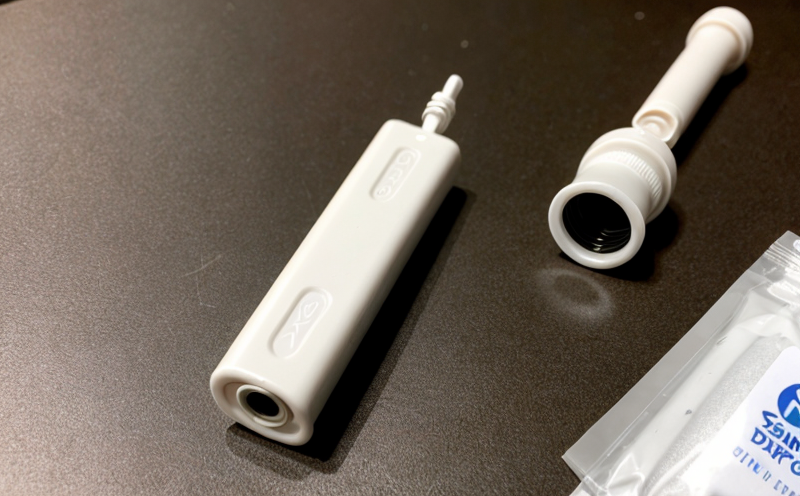Thermal Management Case Temperature Test
The Thermal Management Case Temperature Test is a critical component of ensuring that medical devices function reliably and safely in their intended environments. This test evaluates the performance of single-use and disposable medical devices under specified temperature conditions to ensure they meet regulatory requirements, such as those outlined by ISO 11137-1:2019 and ASTM F838-15.
During this test, specimens are placed in a controlled environment where the temperature is gradually increased or decreased over time. The objective is to assess how well the device maintains its performance characteristics within these temperature variations. This includes checking for any changes in functionality, durability, and safety that might arise due to thermal stress.
One of the primary challenges faced by manufacturers during this process is ensuring consistent and accurate measurement of case temperatures around the device. Inadequate thermal management can lead to degradation of materials used in construction, which may ultimately affect the integrity of the medical product. Therefore, it is essential that laboratories conducting these tests possess sophisticated equipment capable of providing precise measurements.
The testing procedure typically involves placing the device into a climate chamber set at specific temperature ranges corresponding to different environmental conditions. The chamber then simulates various real-world scenarios where the device might be exposed during use or storage. By monitoring the temperature around the device throughout this process, researchers can identify potential issues early on.
Another key aspect of this test is understanding how different types of packaging materials interact with thermal cycles. For instance, certain plastics used in single-use devices may deform when subjected to high temperatures, affecting overall performance or even posing a risk if not properly managed. Through rigorous testing, manufacturers can determine which combinations work best under various conditions.
In addition to evaluating individual components, the Thermal Management Case Temperature Test also helps assess larger assemblies like portable diagnostic machines or wearable health monitoring systems. These devices often rely on multiple interconnected parts that must operate harmoniously across a wide temperature range without failure.
By incorporating this test into their quality assurance protocols, companies demonstrate commitment not only to maintaining product excellence but also safeguarding patient safety by preventing failures caused by improper thermal design.
Why It Matters
The importance of effective thermal management in medical devices cannot be overstated. Failure to adequately manage heat can lead to reduced performance, increased likelihood of malfunction or failure, and ultimately compromise patient care. Regulatory bodies like the FDA (US Food & Drug Administration) emphasize compliance with appropriate standards such as ISO 11137-1:2019 and ASTM F838-15 to ensure that all medical devices are safe for use.
For instance, when designing a portable blood glucose meter, it is crucial to consider how temperature fluctuations might impact sensor accuracy or battery life. Similarly, in the case of an intravenous catheter intended for long-term use, ensuring proper insulation against extreme temperatures can prevent damage to both the device itself and surrounding tissue.
Moreover, manufacturers need to account for variations in ambient conditions across different regions worldwide. For example, devices marketed in tropical climates should be tested under higher humidity levels alongside elevated temperature settings compared to those designed for colder environments. This ensures that products perform consistently no matter where they are sold or used.
The consequences of neglecting thermal management can range from minor inconveniences like occasional readouts being slightly off target to severe outcomes such as life-threatening complications if a malfunction occurs during critical procedures. By implementing thorough testing processes early in the development cycle, companies can mitigate these risks before they become issues.
Benefits
The benefits of conducting a Thermal Management Case Temperature Test extend beyond mere compliance with regulatory guidelines; it provides valuable insights into product performance and helps improve overall quality assurance efforts. Here are some key advantages:
- Enhanced Reliability: Ensures that the device operates correctly across all expected temperature ranges, reducing the risk of unexpected failures.
- Patient Safety: By identifying potential hazards early in development, companies can eliminate risks associated with improper thermal management.
- Increased Marketability: Demonstrating adherence to stringent testing protocols increases consumer confidence and trust in brand reputation.
- Cost Savings: Early detection of problems through rigorous testing reduces costs related to post-market recalls or warranty claims.
Implementing this test also fosters innovation by encouraging continuous improvement based on feedback from real-world applications. Companies can refine their designs iteratively, incorporating learnings gained during each iteration into subsequent versions until they achieve optimal performance under diverse conditions.
Environmental and Sustainability Contributions
The focus on thermal management in medical device testing aligns closely with broader sustainability goals within the healthcare industry. By ensuring that devices perform reliably across various environmental conditions, manufacturers contribute positively towards reducing waste associated with premature disposal due to malfunctions.
In addition, by promoting longer-lasting products through robust testing practices, companies help minimize resource consumption and energy usage throughout a device's lifecycle. For instance, extending battery life or improving material durability leads to fewer replacements needed over time, thereby conserving natural resources and lowering carbon footprints.
Moreover, the emphasis on safe operation under extreme temperatures supports efforts aimed at reducing energy consumption during manufacturing processes. Efficiently designed devices require less power input, which translates into lower greenhouse gas emissions from industrial operations.
As society increasingly prioritizes environmental stewardship, adopting sustainable practices like those promoted by thorough thermal management testing becomes not just a business advantage but also a social responsibility embraced by conscientious organizations committed to making positive contributions towards global sustainability challenges.





